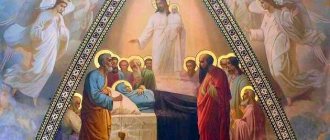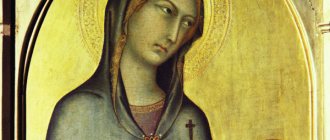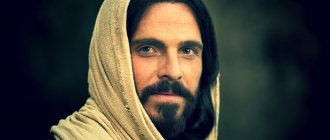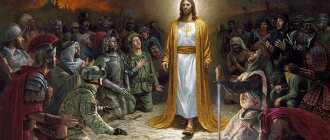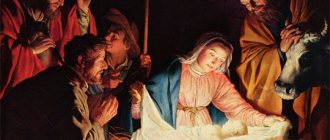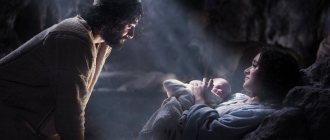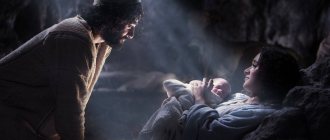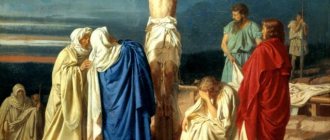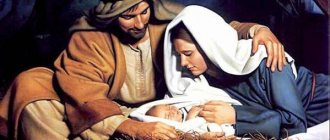Often modern Christians are faced with different opinions and myths about Jesus Christ, not the least of which is that Jesus had a wife. Many researchers of historical facts consider Mary Magdalene to be the wife of Christ, but this is just a widespread myth, which Christians clearly should not believe. The authors of various articles and books discuss this topic; it is definitely worthwhile to completely debunk it so that Christians have no doubts regarding this issue.
The Myth that Jesus Christ Was Married – Basic Facts and Concepts
Photo: Ru.wikipedia.org
The most frequently discussed biblical myth is the myth of the marriage of Jesus Christ to Mary Magdalene. This myth has become the basis of many articles, books and even films that can not only be found on the Internet, but also shown on TV. The most famous film that talks about the union of Jesus Christ and Mary Magdalene is the film “The Da Vinci Code”. Some articles even wrote that secret manuscripts had been found confirming the union of Christ and Mary, saying that scientists were able to uncover a secret that the Vatican was always afraid to reveal.
Fans of the theory of the marriage of Christ and Mary Magdalene often even say that they had children, and these children were credited with the founding of the French dynasty. Naturally, a number of incredible events were then attributed to the children of Christ and Mary, but this was not the case at all.
The appearance of angels to them
They fell on their faces in fear, and two men who appeared to them said: Why are you looking for the Living One among the dead? He is not here: He is risen
(Luke 24:5-6).
Come and see the place where the Lord lay
(Matthew 28:6).
The women entered the cave and saw a young man (angel) in white clothes sitting on the right side. And this angel said to them: Do not be alarmed.
You are looking for Jesus of Nazareth, crucified; He has risen, He is not here. This is the place where He was laid (Mark 16:6).
Remember how He spoke to you while He was still in Galilee, saying that the Son of Man must be delivered into the hands of sinful men, and be crucified, and on the third day rise again.
And they remembered His words (Luke 24:6-8).
Go quickly, tell His disciples that He has risen from the dead and is going ahead of you to Galilee;
there you will see Him (Matthew 28:7).
The words of the angel were conveyed by all the first three Evangelists in complete agreement; the discrepancy concerns only the number of angels and the place where they appeared. The evangelists Matthew and Mark talk about the appearance of one angel, whom Matthew calls an angel, and Mark a young man; The Evangelist Luke says that two men appeared to them. The difference in names (angel, youth, husband) is not significant. Angels, as invisible spirits, must take on some form when they appear to people; but since in this case they appeared in a dazzling brilliance, as a result of which the women, amazed by this wonderful phenomenon, bowed their faces
their
to the earth (Luke 24:5), then it is quite possible that the speaking angel seemed to one to be a young man, and to another to be a man; It is also quite possible that some women saw only one angel who appeared in this form, while others saw two
To prove the reality of the resurrection of Jesus, it did not matter whether one or two angels appeared to the women who came to the tomb; it was important to report what exactly the angel who spoke said, and that the angel who did not speak was also present - this did not matter in relation to the purpose of the story; That’s why two Evangelists tell about one angel who spoke to women, and the third Evangelist supplements their story with an indication of another angel who was right there.
Regarding the place where these words were spoken by the angel, there is also an apparent disagreement between the Evangelists. From Luke's narrative it is not at all clear where the angel spoke, in the cave or outside it. Mark testifies that the appearance of the speaking angel took place in a cave. And Matthew, although he says that the angel rolled away the stone from the door of the tomb and sat on it
(Matthew 28:2), but where exactly he addressed the women with words of consolation is not clear from his narrative;
Let us suppose that the expression - come, look at the place where the Lord lay
(Matthew 28:6) - gives some reason to believe that the angel said this while outside the cave, perhaps sitting on a stone;
but since the stone was rolled away before the arrival of the women, it can be said with high probability that the angel sitting on the stone and shining like lightning was seen by the soldiers, who trembled at this and became like dead men
(Matthew 28:4), and the women could see him already in the cave. However, one can also assume the following situation: an angel appeared to all the women outside the cave, at the entrance to it, announced that Christ had risen, and invited them to enter the cave to see where the Lord lay in order to make sure that He had truly risen; when they entered the cave, they saw (as Mark says) a young man sitting on the right side; and then they heard the voice of an angel speaking to them (or continuing to speak), and they could see the same angel, but who appeared to them again in the cave, receiving another, as a result of which Luke says that two men appeared to them.
Be that as it may, for the Evangelists it was only important to establish that the stone had been rolled away, that the tomb was empty, and that the reason for such emptiness was explained to the angel who appeared to the women; whether there were two angels or one, and where exactly he spoke, did not matter significantly to the Evangelists. After all, they did not carry out police investigations and did not draw up protocols in which all sorts of little things and details were recorded in detail; no, they reported only the main events that led them to the conviction that Christ really rose again
We debunk the most popular myth - how it really happened
Photo: pravmir.ru
If we talk about the article in the newspaper “Independent”, where the above theory was described, then it is worth saying that under the guise of a secret document revealing the truth about the marriage life of Jesus, the author refers to a text called “Joseph and Asenath." Revealing the true meaning of this long-standing apocrypha, it is worth talking about its following nuances:
- the main hero of the apocrypha is Joseph the Beautiful - an Old Testament hero who married the daughter of Potiphera, who is a Geol priest;
- in this marriage Ephraim and Manasseh were born (Gen. 41:45, 50–52; 46:20);
- there is almost no information about the wife of Joseph the Beautiful in the Bible, which became the basis for speculation regarding the reliability of Biblical texts;
- the basis of the above-mentioned text is the story of the appeal of the wife of Joseph the Beautiful to God; the document was known a long time ago, so it is not clear why it is supposedly made secret;
- in this text they do not mention Jesus Christ and Mary Magdalene anywhere, but for some reason historians and newspapermen drew a parallel between the main characters of the apocrypha and Jesus and Mary.
This brings up the fact that the history of the Old Testament heroes cannot be regarded as written evidence of the marriage of Mary and Jesus, because the apocrypha says something completely different. Newspapers and historians have already speculated that in this document, under the names of Joseph and his wife, the names of Jesus and Mary were encrypted, but this is far from true and there is no direct evidence of this.
Did Mary Magdalene have children with Jesus Christ?
Mary Magdalene is rightfully considered the most mysterious character in the New Testament. We know nothing about her childhood, her parents, or her loved ones.
We know nothing about her life either. In any case, none of the four Gospels can tell us how this woman lived after the execution of Jesus Christ. ..
When there is little information, they make it up. The Fathers of the Church also had to think about this information when the question arose: to make the aforementioned Mary a saint or not?
Since Mary Magdalene was the first to behold the risen Christ, it was difficult to get rid of this character. And she was canonized, but... under special conditions - by attributing to the unfortunate woman actions and deeds that she had never committed! In the church understanding, the holiness of Magdalene was expressed in the fact that she turned from a great sinner into a great righteous woman.
Scrolls from Nag Hammadi. A Coptic theologian claimed that Jesus often kissed Mary of Magdala on the lips and considered her his favorite disciple
One and a half thousand years have passed, and modern researchers of Magdalene’s life did exactly the opposite with her: they made a great sinner out of a great righteous woman and declared that this was wonderful. Who exactly was this extraordinary woman?
Entity multiplication
Mary first appears in the Bible when Jesus cast out seven demons from her. Having been healed, the woman followed the Savior and became one of His admirers.
Mary of Magdala was a wealthy woman; she willingly took on Jesus' expenses. When Jesus was captured and sentenced to death, she was present at the execution along with two other Marys - the mother of Christ and the sister of Lazarus. She participated in the burial of Jesus and anointed His dead body with Myrrh.
It was she who came to the cave where Jesus was buried and discovered that His body had disappeared. And it was she who first saw the risen Christ and told the apostles about him. It was also mentioned that she visited Rome, where she also spoke about Christ.
Nothing more can be extracted from the New Testament. But besides the four canonical Gospels, there are several that are not recognized by the church, that is, non-canonical. These Gospels were rejected by the church because of their Gnostic (teachings hostile to Christianity) origin and content.
In the first centuries, when Christianity had not yet formed into a world religion, some Christians shared the views of the Gnostics, who affirmed the knowability of God and the possibility of acquisition by any person through knowledge of the divine essence. In the Gnostic Gospels, Mary of Magdala was given a very important role. She was considered the beloved and most faithful disciple of Christ. Mary herself was the author of one of the Gospels - the Gospel of Mary Magdalene.
Judging by this text, Mary of Magdala was most interested in the question of posthumous transformations of the soul. It is not for nothing that the non-canonical Gospels claimed that this woman became the founder of a philosophical Christian community and her own church. Of course, official Christianity smeared these Gospels as dangerous and incorrect. And it offered a completely different image of Mary of Magdala.
From student to student
It didn’t take much effort to turn a faithful student into a representative of the first ancient profession. It was only necessary to unite with Mary of Magdala all the women mentioned but not named in the New Testament.
The first candidate to complete the image of Magdalene was the woman who washed Christ’s feet with myrrh and wiped them with her hair. Another candidate is the woman who anointed Christ's hair. The third is the harlot whom Jesus saved from stoning and who followed him. As a result, unnamed women easily turned into the already famous Mary of Magdala.
The image of the improved Mary became like this: before, she walked around with a painted face and loose hair and engaged in prostitution, but Jesus saved her from death, cast out demons from her, which should be understood as vices, and Mary became a virtuous and faithful companion of the apostles.
Somewhere in the background of the Gospels she was with Susanna, Joanna and Salome. Only the mother of Jesus, in view of her complete purity and inspiration of God, was allowed to take a place next to Jesus, and only because He was her son.
Orthodox Christians had a simple attitude towards women: they were all daughters of Eve, who succumbed to temptation in paradise and thus burdened humanity with original sin. Mary of Magdala simply repeated the path of Eve, but in the opposite direction - she was cleansed from sin by her faith. And when Christians in the fifth century appeared Saint Mary of Egypt, who in her earthly life actually engaged in fornication, but repented, the image of Magdalene was completed. They say she is a harlot and nothing else.
The kiss that offended the apostles?
Centuries have passed. In 1945, famous scrolls written in Coptic were found in Nag Hammadi, Egypt. These were the same texts not recognized by the church that miraculously survived the period of struggle against heresies. Here it was unexpectedly revealed that Jesus called Mary of Magdala his beloved disciple and often kissed her on the lips.
And the other disciples were very jealous of Christ and even demanded an explanation from him why he singled out this Mary to the detriment of the others. Jesus answered this allegorically and evasively. Modern researchers immediately had a nasty suspicion that Jesus did not kiss Mary of Magdala as a disciple...
Mary Magdalene embraces the cross on which the Savior was crucified. She could not hug Jesus during life, but she could after death. In all the paintings and icons, she worries about the death of the Savior more than any of the apostles
Researchers were quick to note that Jesus did not just kiss Mary, but often on the lips. The peculiarity of such kisses in the 20th century was clear as day. There were two options why Jesus kissed Mary on the lips - either He lived with his disciple in sin, or He was simply married to her.
The sinful relationship somehow denigrated the name of Jesus. Well, Jesus having a wife did not contradict the Jewish laws of that time; on the contrary, a man of Jesus’ age was simply obliged to have a wife! But while in the sixth century it was possible to turn Magdalene into a harlot based on the text, in the twentieth century it was no longer possible to turn Jesus into a married man. More than one generation of theologians has worked on the purity and integrity of His image!
So He couldn’t have any wife, because He wasn’t supposed to. And the question of why Jesus kissed Mary Magdalene on the lips began to be answered with murderous logic: because in the first century it was customary among Christians to kiss each other on the lips. But the essence of the question still eluded those who answered: why then did Jesus do this so often that the other disciples were offended and indignant?
Mother of Jesus' Heirs
And then a revelation appeared from British historians and archaeologists Baigent, Ley and Lincoln, “The Sacred Riddle,” where Magdalene was declared not only the companion, disciple and wife of Jesus Christ, but also the mother of His children.
In general, there is nothing surprising in the existence of children of a married man. If, of course, it weren’t for the man’s name. But in early Christian times, such versions existed safely. Let's say that some features of the knightly era are to blame for this. Even the name of Mary Magdalene was deciphered as “Mary of the city of Magdal-El,” which in turn was simply translated as “Mary of the city with towers.” Images of Mary from Magdala were readily complemented by the turret in the background.
In that wonderful era, apocryphal (hagiographical) texts appeared that depicted Magdalene’s life as follows. She was the spiritual wife of Jesus and through the virgin birth gave birth to his son Joseph the Sweetest
. This baby became the ancestor of the royal house of the Merovingians. To save the child, Magdalene had to flee to Marseille. But soon her earthly life ended, and Jesus took her to heaven in the Bridal Chamber.
There is another legend. According to her, Magdalene had two children
- boy and girl: Joseph and Sofia. Magdalene lived to a ripe old age and was buried in the south of France.
Although Magdalene is mentioned only 13 times in the New Testament, after she was declared a saint, holy relics of Magdalene also appeared. Bones, hair, coffin chips and even blood. There was a desperate struggle for the relics of Magdalene, and in the eleventh century there was even a period that historians call the “Magdalene ferment”!
Mary Magdalene was worshiped not only by the Albigensian heretics, but also by the Knights Templar. It is not for nothing that the knightly Baphomet personified the “baby Magdalene” Sophia, that is, Wisdom. But already in the Renaissance, the image of the repentant Magdalene became the favorite image of artists. As the time goes, so do the images and relics. Nikolay KOTOMKIN “Mysteries of History” November 2012
Miracles
- Turning water into fine wine.
- Healing the paralyzed.
- The miraculous resurrection of Jairus's daughter.
- Resurrection of the son of the Nain widow.
- Calming the storm on Lake Galilee.
- Healing of the Gadarian demoniac.
- The miraculous feeding of the people with five loaves.
- Walking of Jesus Christ on the surface of the water.
- Healing of the Canaanite daughter.
- Healing of ten lepers.
- The miracle on Lake Gennesaret is the filling of empty nets with fish.
The Son of God instructed people and explained each of his commandments, inclining them to God’s teaching.
Jesus Christ healing a blind man
The Lord's popularity grew every day and masses of people rushed to see the miraculous preacher. Jesus bequeathed the commandments, which later became the foundations of Christianity.
- Love and honor the Lord God.
- Don't worship idols.
- Do not use the name of the Lord in empty conversations.
- Work six days, and pray on the seventh.
- Respect and honor your parents.
- Don't kill another or yourself.
- Do not violate marital fidelity.
- Do not steal or appropriate other people's property.
- Don't lie and don't be jealous.
Commandments of Jesus Christ
But the more Jesus won people's love, the more the nobles of Jerusalem hated him. The nobles were afraid that their power would be shaken and conspired to kill the messenger of God. Christ triumphantly enters Jerusalem on a donkey, thereby reproducing the Jewish legend about the triumphant coming of the Messiah. The people enthusiastically greet the New Tsar, throwing palm branches and their own clothes at his feet. People expect that the age of tyranny and humiliation will soon end. With such pandemonium, the Pharisees were afraid to arrest Christ and took a wait-and-see attitude.
A crowd of people meets Jesus Christ
The Jews expect from Him victory over evil, peace, security and stability, but Jesus, on the contrary, invites them to renounce everything worldly and become homeless wanderers who will preach the word of God. Realizing that nothing would change in power, people hated God and considered God a deceiver who had destroyed their dreams and hopes. The Pharisees also played an important role here, inciting a rebellion against the “false prophet.” The surrounding situation becomes more and more tense, and Jesus step by step approaches the loneliness of the Gethsemane night.
When did Jesus die?
Biblical sources agree that Christ was sentenced to death and crucified during the reign of the Roman procurator Pontius Pilate in Judea. The Gospel tells how the sky darkened for several hours after the crucifixion, which was perceived by witnesses as a miracle and an omen of future disasters.
Therefore, many historians associate the date of Christ's crucifixion with a total solar eclipse in 29 AD, which lasted approximately two minutes. Other researchers cite a longer eclipse (more than 4 minutes) in 33 AD.
Pilate addresses the crowd of Jews, calling for mercy on Christ / ©Painting by Antonio Ciseri/ wikimedia
Dynastic marriage
If we go back to the wedding in Cana, it was definitely a very important event. Hundreds of guests, many efficient servants... A certain “manager” led the feast. Wine flowed in abundance, including that which Jesus transformed from water. In a word, it was a brilliant and rich reception where a refined society gathered. Doesn't the presence of Christ on him indicate that he also belonged to the elite? If we assume that it was his own wedding with Magdalene, and, as we have seen, there are some grounds for this, we can go even further.
At the very beginning of its history, the authors of the book note, Jerusalem belonged to the descendants of the tribe of Benjamin. As a result of enmity with the other tribes of Israel, Benjamin had to go into exile, but some of his fellow tribesmen remained in their homeland, not wanting to leave it. Power from the tribe of Benjamin passed to King David from the tribe of Judah, who established his capital in Jerusalem and deprived the descendants of Benjamin of the rights to the throne and legal inheritance. Jesus belonged to the descendants of David and, from the point of view of the people of the tribe of Benjamin, was a usurper. But everything would change if he married a woman from the tribe of Benjamin. The union of two hostile dynasties in this case would have serious political consequences: Israel would receive a king-priest, the tribe of Benjamin would regain its legal rights, and Jesus' rights to the throne would become justified. In this way, Christ could unite the country, restoring the monarchy to its former glory. Doesn't this explain his nickname - King of the Jews?
The mystery of the Shroud of Turin: fake or sacred?
In the main cathedral of Turin there is a linen cloth with the imprint of a man wearing a crown of thorns and blood stains. Believers believe that this is a genuine image of Christ. According to the Gospels, after dying on the cross, Jesus' body was wrapped in a shroud and buried according to Jewish rites in a cave carved into the rock.
The Orthodox Church is inclined to believe in its authenticity. The Catholic Church is not convinced of this and venerates it rather as a symbolic relic.
Shroud of Turin: positive (left) and negative. Reuters
Scientists agree that this is a medieval fake. Radiocarbon dating carried out in 1988 in laboratories in three different countries showed that the fabric was made between 1260 and 1390. This coincides with the first appearance of the shroud (1354) and its first presentation to the general public (1389).
At the same time, the nature of the print on the fabric, which is essentially a photographic negative, remains a mystery to this day.
Image of a face on the shroud (negative). Depositphotos
Nowadays, the shroud has been studied using advanced methods of forensic medicine and criminology. In 2018, it was once again stated that this was an imitation, since blood stains in such an arrangement could only be left by someone who was moving, standing and taking different poses, but not by a person lying motionless.
We advise you to study Zodiac Signs and Coronavirus. Which signs are most susceptible to coronavirus infection?
